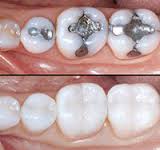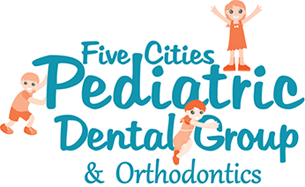Fillings

Modern dental fillings include a mixture of glass and plastic compounds that mimic the appearance of natural teeth. These compounds, often called composite resins, are usually used on the front teeth where a natural appearance is important, as well as on the back teeth depending on the location and extent of the tooth decay.
New technology allows the placement of many fillings without needing tooth numbing (local anesthesia). Sometimes, a tooth defect or decayed area is too large to reliably place a filling. In these cases, a crown may be recommended. At our practice, white crowns are used on front teeth.
Direct fillings are fillings placed immediately into a prepared cavity in a single visit. They include composite resin fillings (white), glass ionomers (white), and amalgam fillings (silver). The dentist prepares the tooth, places the filling, and adjusts it in just one appointment. The photo shows the difference in the appearance of amalgam fillings (top) and composite resin (bottom)
Sealants

Sometimes brushing is not enough, especially when it comes to those hard-to-reach spots in your mouth. It is difficult for your toothbrush to get in between the small cracks and grooves on your teeth. If left alone, those tiny areas can develop tooth decay. Sealants give your teeth extra protection against decay and help prevent cavities.
Dental sealants are plastic resins that bond and harden in the deep grooves on your tooth's surface. When a tooth is sealed, the tiny grooves become smooth and are less likely to harbor plaque. With sealants, brushing your teeth becomes easier and more effective. We are proud to offer sealants that are free of BPAs (bisphenol-A).
Sealants are typically applied to children's teeth after their permanent teeth have erupted as a preventive measure against tooth decay. However, adults can also receive sealants on healthy teeth. It is more common to seal permanent teeth rather than baby teeth, but every patient has unique needs, and your dentist will recommend sealants on a case-by-case basis.
Sealants typically last from 3-5 years, although it is fairly common to see adults with sealants still intact from childhood. A dental sealant provides the most protection when it is fully intact, so if sealants come off, let the dentist know, and an appointment can be scheduled for your child's teeth to be resealed.
Fluoride
Fluoride is effective in preventing cavities and tooth decay by making the tooth enamel more resistant to acid attack by bacterial plaque, and by preventing plaque from building up and hardening on the tooth's surface.
Fluoride comes in two varieties, systemic and topical:
- Systemic fluoride is usually taken into the body through a public water supply. While teeth are forming under the gums, the fluoride strengthens tooth enamel, making it stronger and more resistant to cavities. In communities without a fluoridated water supply, a fluoride supplement may be indicated-- please ask our clinical staff at your child's appointment whether a supplement may be helpful.
- Fluoride can also be appliedtopically to help prevent caries (cavities) on teeth present in the mouth. It is delivered through toothpaste, mouthwash, and professional fluoride applications. Professional application of topical fluoride gels and varnishes is also a valuable tool for enamel strengthening and cavity prevention.
Receiving a fluoride treatment from your dentist
A fluoride treatment in the dentist's office takes just a few minutes. After the treatment, patients may be asked to not rinse, eat, or drink for at least 30 minutes in order to allow the teeth to absorb the fluoride. Depending on your child's oral health or your doctor's recommendation, your child may be required to have a fluoride treatment every three, six, or 12 months. Your doctor may also prescribe topical fluoride products for home use.
How to choose the right fluoride treatment
When choosing an at-home fluoride product (such as toothpaste or mouthwash), always check for the American Dental Association's (ADA) seal of acceptance. Products marked with the ADA seal of approval have been carefully examined and approved by the ADA based on safety and effectiveness. And remember, if your child is taking a fluoride supplement and using a fluoridated toothpaste, an additional fluoride rinse is generally NOT recommended.
Sports Dentistry
Sports dentistry is the prevention and treatment of dental injuries and related oral diseases, as well as the sharing of information and equipment designed to help protect the teeth, mouth, jaw, and face of athletes of all ages. Injuries to the teeth and mouth are common among athletes. It's important to protect your child's smile if he or she plays sports, for aesthetics as well as health reasons.
Common Dental Injuries in Sports
Tooth knocked out:
- Time is the most important factor when trying to save a tooth, so get to your dentist as soon as possible. In general, there is a 30-minute window of opportunity to re-implant the tooth in the socket.
- Do not try to re-implant the tooth yourself.
- The best liquid to transport a tooth in is cold milk. If milk is not available, use saliva (if possible), saline, or if nothing else is available, water.
- Don't let the tooth dry out and don't wrap it in anything.
- Don't touch the tooth root if you can avoid it.
Tooth chipped/cracked:
-
Your dentist will likely use an X-ray of the tooth to determine the treatment necessary.
- For a serious chip that exposes the pulp of the tooth, get to your dentist as soon as possible.
- If a tooth is chipped or cracked, sometimes the tooth can be fixed with a filling or bonding alone.
- Sometimes a tooth is cracked or chipped in a way affecting the nerve of the tooth, and a more complicated treatment may be needed.
Tooth displaced:
- If a tooth is moved due to trauma, see your dentist as soon as possible.
- Do not try to move the tooth back on your own.
- For any mouth discomfort before you get to the dentist, apply ice.
Preventing Injury
One of the best ways to prevent injury to your child's teeth and mouth is to have him or her to wear a mouthguard while playing sports. There are several types of mouthguards to choose from, and your doctor can help you choose the best one for your child's particular needs.


